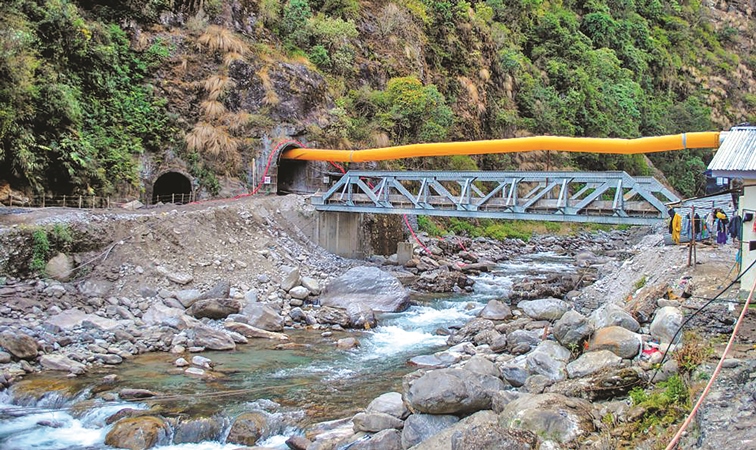Burgeoning Need For Water And Melamchi

Anu Rai
In my early teens, I remember my mother waking up at around 3 am to store water for our family. In a sleep deprived condition, sometimes the disagreement with the tenants of the house used to take place over water, sometimes leading to fights. The water crisis in Kathmandu has burgeoned on for long now.
It has almost been two decades that the Melamchi Water Supply Project (MWSP) has been implemented. It is a project expected to be completed by 2006. If we go back into the project's envisioning process, we can find out that it was towards the end of 1986 that Melamchi was first brought into attention of being the World Bank's Water Supply Project.
A series of events led the project to be taken up by Asian Development Bank in the mid-1990s. Now, the first phase of the project has been announced to be completed by mid-July 2020. The deadline is again expected to be extended due to the COVID-19 pandemic.
In total, the project will divert 510 million litres water per day (MLD) for Kathmandu Valley from Melamchi, Yangri and Larke rivers of Indrawati River basin with the first stage bringing 170 MLD of freshwater to Kathmandu Valley. However, according to the latest report from Kathmandu Upatyaka Khanepani Limited (KUKL), the entity responsible to manage drinking water supply in Kathmandu Valley, on average there is a 234 MLD water deficit in Kathmandu Valley without even considering 20 per cent real losses.
Hence, the first phase of water transfer will be insufficient. With studies in projection rate by Thapa et al., severe water insecurity condition is likely to improve after completion of the MWSP. However, the recent distribution network and strategies is opined to lead to inequality in water distribution within the service areas. Thus, the sad reality is MWSP alone cannot solve the water crisis for Kathmandu Valley. We need to think beyond Melamchi. But first let's look at some important information before outlining the majors for solutions.
The gap in water demand in Kathmandu Valley is currently being met through private groundwater extraction by households and vendors. According to Chinnasamy and Shrestha, there has been substantial overexploitation of groundwater with almost 69,440 million litres of groundwater extracted annually (considering all extractions from private and community, Kathmandu Upatyaka Khanepani Limited and Nepal Water Supply Corporation) causing a drawdown of the groundwater surface of 15–20 m since the construction of wells in 1984/85.
So, depending on groundwater to fend our needs is clearly not an option. Now let's talk about the water tariff system. KUKL’s existing water tariff follows Increasing Block Tariff (IBT) which depends on consumption by volume and a connection tape size. As of last revision on water tariff, KUKL customers with a half inch connection size have to pay NRs. 100 for 10,000 litres of water per month (for metered connection, unmetered charged NRs. 785 for the same connection).
Within the lifeline block of 10,000 litres a customer pays the same amount i.e. same charge for use of 3000, 7000 or 10,000 litres. This hardly encourages wise use of water.
Thus, we need to divert of attention to alternate mitigation options such as rainwater harvesting process, harnessing additional water sources, water demand side management among others. The tariff mechanisms also require change.
Since Kathmandu Valley residents are already paying approximately 3.4 times as much for vended water (information obtained from survey by Raina et al.), a unique opportunity persists in increasing water tariff provided improved quality of water delivery.
Ojha et al. have suggested increasing the water price by 54 per cent to meet operation and maintenance costs. However, whatever course of action is planned, one thing is sure- we cannot have an overdependence on Melamchi water.
(Rai is freelance environmental researcher)
Recent News

Do not make expressions casting dout on election: EC
14 Apr, 2022
CM Bhatta says may New Year 2079 BS inspire positive thinking
14 Apr, 2022
Three new cases, 44 recoveries in 24 hours
14 Apr, 2022
689 climbers of 84 teams so far acquire permits for climbing various peaks this spring season
14 Apr, 2022
How the rising cost of living crisis is impacting Nepal
14 Apr, 2022
US military confirms an interstellar meteor collided with Earth
14 Apr, 2022
Valneva Covid vaccine approved for use in UK
14 Apr, 2022
Chair Prachanda highlights need of unity among Maoist, Communist forces
14 Apr, 2022
Ranbir Kapoor and Alia Bhatt: Bollywood toasts star couple on wedding
14 Apr, 2022
President Bhandari confers decorations (Photo Feature)
14 Apr, 2022











